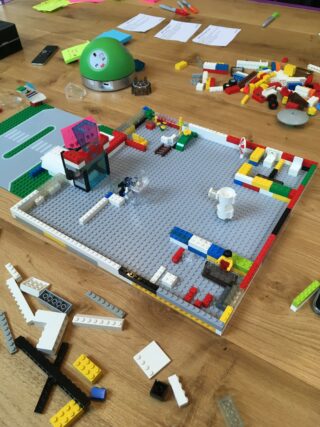Having worked as a project manager in both commercial and public sectors, I was interested in how the Agile framework might be used to develop the delivery of Quality Improvement work within the NHS. I have mainly used waterfall methodologies such as PRINCE 2 and MSP for running large projects. Whilst this has worked well for larger programmes which involve formal public consultation or procurement, these methodologies don’t feel flexible enough for continuous improvement. I love learning new things and developing skills and have recently completed my Scrum Master qualification and so I jumped at the opportunity to attend the Q visit to Mayden to see Scrum being applied in practice.
The group reflected that the Scrum framework fitted really well with Quality Improvement in the NHS. Providing a framework for empowering teams to self-direct and with continuous adaption and improvement felt really positive.
Mayden develop digital technology for healthcare; one of their main products supports the delivery of Improving Access to Psychological therapies (IAPT). The Mayden team were so welcoming and opened the session with a few fun ice-breakers. They explained they were on an improvement journey and whilst they had come a long way in becoming a more agile organisation, they were still continuing to learn and improve. Currently, the Mayden team are looking at how to apply the Agile approach to their non-technical teams, such as marketing.
The session opened with an explanation of some of the key components of Scrum (a type of Agile):
- A product backlog. This is a list of work which needs to be completed, written as stories from the perspective of the user.
- An agreed definition of done. This ensures that everyone is clear from the start what completed means.
- Sprint planning. The team look at the list of work and decide collaboratively how much work they can get done within the timeframe, otherwise known as a ‘sprint’ (these are normally between 1 and 4 weeks).
- Daily Stand ups. These are discussions that last up to 15 minutes where everyone checks in and considers how they can support each other to help deliver the sprint objective, allowing an opportunity for learning and adaptation along the way.
- Retrospective. This is a more formal reflection of what has worked well throughout the sprint and considering learning which could be applied into the next one.
 The idea behind this methodology encourages teams to become more self-directing, work together and hold each other to account. The regular feedback process allows team members to learn, adapt and change throughout the process.
The idea behind this methodology encourages teams to become more self-directing, work together and hold each other to account. The regular feedback process allows team members to learn, adapt and change throughout the process.
Following the theory, everyone got a chance to apply it to the shared task of building a Lego Space Hotel. We were spilt into groups and all given the same task. Each group could select from the product backlog how much work they wanted to take on in the time and chose a Scrum Master. The role of the Scrum Master was not to direct or organise the team but to unlock any barriers to progress and facilitating when necessary.
Our group ambitiously agreed that we would attempt nine of the 14 items in the product backlog (despite having been instructed to only take on the work we felt we could complete in the time and being told we could always pull more work from the backlog if we had spare time at the end!) We agreed between ourselves who was going to focus on which tasks during the sprint planning before going into our first 8 minute sprint.
Before the next sprint we held our ‘daily’ stand-up where we identified that we had focused too much on the detail (flowers and sofas) rather than building the main structure. We then reallocated the work with more people focused on finding larger bricks and building the main structure. By the third ‘daily’ standup we had entirely caught up and agreed we could pull forward an additional item (story) from the product backlog. We even had time left to tidy up! At the end of third sprint we had completed the space hotel and had some time for reflection. The application of the theory into a practical task had really helped us understand through experience and embed the learning.
So how could Scrum be applied into a healthcare setting? The group reflected that the Scrum framework fitted really well with Quality Improvement in the NHS. Providing a framework for empowering teams to self-direct and with continuous adaption and improvement felt really positive. There were a few words of concern for the group that people are often over committed in the NHS and whilst they want to complete something when they have said they would, there are often other demands on their time and they can’t focus on the task. Generally, people liked the idea of having some time for planning, some time for doing and time for reflection and adaptation throughout the process and then reflection before starting again.
Overall, I really enjoyed the day, lots of laughter and learning and can’t thank the team at Mayden enough for sharing and Q community for organising. I will definitely be trying some of the things out into my work!
Comments
Amy Shortridge 24 Apr 2019
Ruth - this sounds a really fun and relevant methodology to get teams energised to action around the right things to do (ie from a user perspective) interested to understand more and how this could possibly be a masterclass for our current leadership programme Give me a call. A